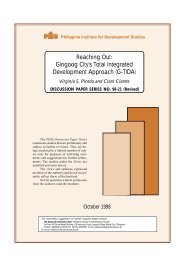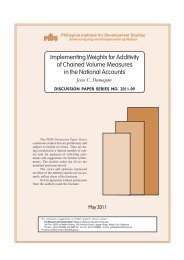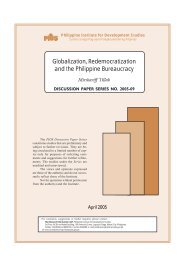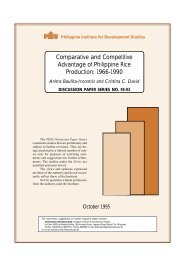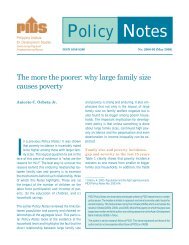Conditional Cash Transfer Program in the Philippines: Is It Reaching ...
Conditional Cash Transfer Program in the Philippines: Is It Reaching ...
Conditional Cash Transfer Program in the Philippines: Is It Reaching ...
Create successful ePaper yourself
Turn your PDF publications into a flip-book with our unique Google optimized e-Paper software.
The CCT programmes have been fairly successful <strong>in</strong> upper middle-<strong>in</strong>come countries likeBrazil and Mexico, but this does not mean that it can work <strong>in</strong> all countries. Several low-<strong>in</strong>comecountries which have adopted <strong>the</strong> model like Guatemala, Honduras and Nicaragua have facedimmense challenges <strong>in</strong> implement<strong>in</strong>g CCT programmes because <strong>the</strong>y did not meet <strong>the</strong> necessaryprerequisites (Cecch<strong>in</strong>i, 2009). The first requirement is that <strong>the</strong>re has to be a multidimensionalapproach to poverty reduction, hence demand<strong>in</strong>g coord<strong>in</strong>ation among all agencies implement<strong>in</strong>gpoverty reduction efforts. Therefore, strong and coord<strong>in</strong>ated <strong>in</strong>stitutions are critical. Second, ithas to be a state policy where<strong>in</strong> <strong>the</strong> programme can withstand changes <strong>in</strong> adm<strong>in</strong>istrations andfund<strong>in</strong>g must not rely from external sources for <strong>the</strong> programme needs to be susta<strong>in</strong>ed for a longperiod of time. Third, <strong>the</strong>re has to be strong statistical capacity and bank<strong>in</strong>g systems. Suchimportant prerequisites are often lack<strong>in</strong>g <strong>in</strong> low-<strong>in</strong>come countries (Cecch<strong>in</strong>i, 2009).Ano<strong>the</strong>r important requirement to achieve successful results from <strong>the</strong> CCT is thatimpos<strong>in</strong>g conditions should mean that <strong>the</strong> necessary services are <strong>in</strong> fact <strong>in</strong> place and that <strong>the</strong>y areof good quality. For <strong>in</strong>stance, provid<strong>in</strong>g some cash to families on <strong>the</strong> condition that <strong>the</strong>ir childrenattend school or do health check-ups is <strong>in</strong>appropriate <strong>in</strong> areas where <strong>the</strong>re are no school oraccessible health centers nearby to go to. Thus, CCT funds should not only be devoted tostimulat<strong>in</strong>g demand for social services but also by <strong>in</strong>creas<strong>in</strong>g <strong>the</strong> supply of social services likeeducation and health services to meet <strong>the</strong> <strong>in</strong>creas<strong>in</strong>g demands.In 2008, when <strong>the</strong> Philipp<strong>in</strong>es launched nationwide <strong>the</strong> CCT, <strong>the</strong>re were still greatshortages <strong>in</strong> classrooms and school teachers and various issues still plague <strong>the</strong> health sector. In2011, <strong>the</strong> supply side allocations for <strong>the</strong> 4Ps <strong>in</strong>clude 12.4 billion pesos for build<strong>in</strong>g classroomsand 1.6 billion pesos for <strong>the</strong> creation of 10,000 teach<strong>in</strong>g positions. The government alsoallocated 7.1 billion pesos for upgrad<strong>in</strong>g of health facilities (NAPC Part 1, 2011). Hence, <strong>the</strong>government realizes <strong>the</strong> importance of supply-side factors to achieve <strong>the</strong> goals of <strong>the</strong> 4Ps. Thus,it would have been better to put <strong>in</strong> place <strong>the</strong>se facilities prior to ra<strong>the</strong>r than concurrently with <strong>the</strong>expansion of <strong>the</strong> program. Hence, <strong>the</strong> lack of preparedness towards full implementation of <strong>the</strong>CCT was truly one of <strong>the</strong> critical issues. Moreover, <strong>in</strong> 2011, <strong>the</strong> NAPC writes that <strong>the</strong>re were somany uncoord<strong>in</strong>ated and overlapp<strong>in</strong>g poverty-reduction-related programs reflect<strong>in</strong>g <strong>the</strong> lack ofcoord<strong>in</strong>ative mechanisms among various agencies.Apparently, <strong>the</strong> Philipp<strong>in</strong>es lack preparedness based on <strong>the</strong> requirements described <strong>in</strong>Cecch<strong>in</strong>i (2009). Fernandez and Olf<strong>in</strong>do (2011) noted that <strong>the</strong> program was scaled up when <strong>the</strong>systems were still under development and this posed considerable challenges <strong>in</strong> <strong>the</strong>implementation. In particular, <strong>the</strong> study noted that <strong>the</strong> rigid <strong>in</strong>stitutional structure and weakprocurement system have constra<strong>in</strong>ed <strong>the</strong> expansion of human and capital support for <strong>the</strong>Pantawid Pamilya. Fur<strong>the</strong>rmore, <strong>the</strong> study highlighted that <strong>the</strong> rapid expansion has also posedchallenges to supply-side read<strong>in</strong>ess <strong>in</strong> areas where Pantawid Pamilya were implemented. Thereare several questions that need answers. Why <strong>the</strong> rush <strong>in</strong> implement<strong>in</strong>g <strong>the</strong> program at such an11





